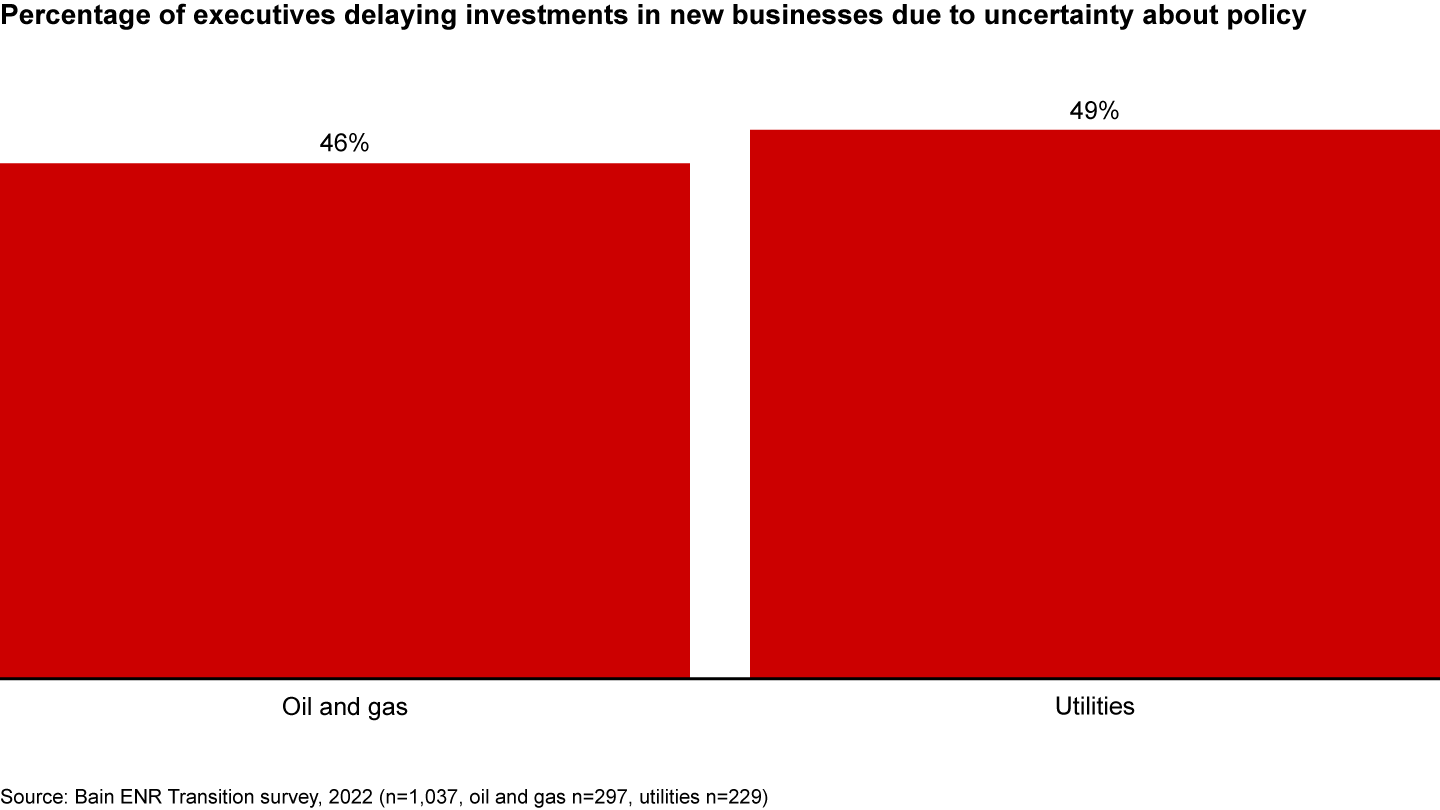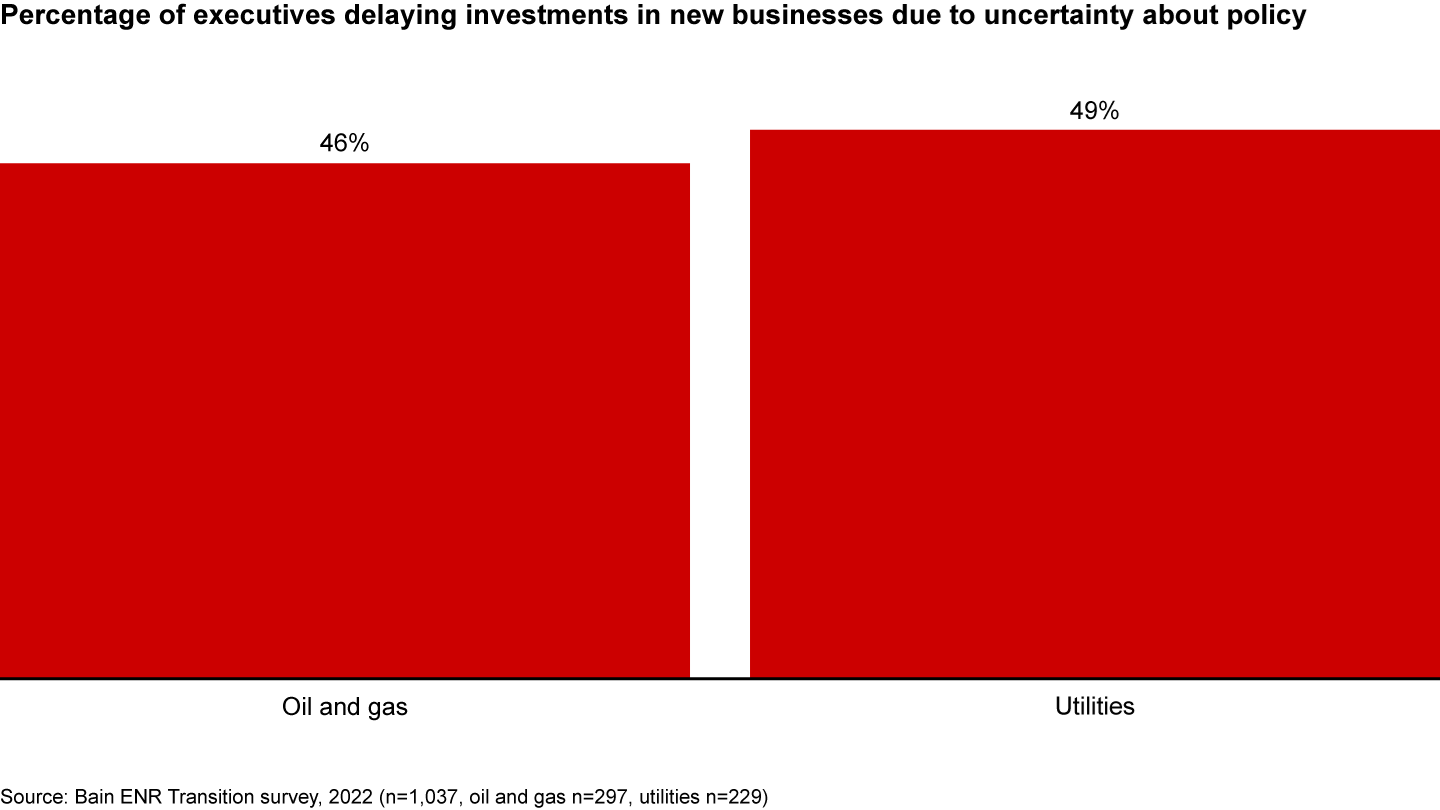Energy & Natural Resources Report

En Bref
- Companies have always needed to pay attention to stakeholders, but more sophistication is required now since the changes required by the energy transition touch many aspects of industry and society.
- Executives of ENR companies are focused on decarbonization but see the lack of clear and stable government policy as a major barrier to investment in new growth businesses and transformational change.
- A comprehensive decarbonization effort demands a coordinated approach. Coalitions of companies, government agencies, citizen groups, and other nongovernmental organizations can be catalysts to accelerate essential policy changes.
This article is part of Bain’s Energy and Natural Resources Report 2022
Europe’s efforts to reduce dependence on Russian oil and gas have highlighted the issues of energy security and supply to a degree not seen in decades.
For many, the impetus to decouple Europe’s energy demand from Russian supply creates a logical incentive to accelerate the energy transition. The European Union’s REPowerEU program, for example, includes a broad collection of measures, including diversifying the supply of natural gas, speeding up electrification of mobility, and improving the electrical system by removing bottlenecks in infrastructure.
At the same time, others see the current moment as requiring a step back from the race to decarbonize, encouraging more fossil fuel development and use as a way of offsetting the lost supply of Russian oil and gas—lost, at least, to Western nations imposing sanctions. Some coal share prices rose as much as 400% in the first weeks of the war, as traders prepared for global demand to spike.
Most of the energy executives that we speak with agree that the long-term direction is clear: We must continue to decarbonize and create a more sustainable, lower-carbon economy. Everyone seems to agree that’s where we want the world to go by 2050.
But 2050 is long way off. The more imminent question is, “How do we navigate the transition in the next 5 to 10 years?”
Delivering the energy transition is complex
We’ve already come a long way. In most places, the cost of renewable energy is already competitive with fossil fuel power. With the precipitous fall in battery prices and longer lifetimes, electric vehicles (EVs) have reached lifetime cost parity in key markets.
What’s more, energy executives tell us they’re eager to invest more (and more rapidly) in sustainable, lower-carbon assets. They’re under pressure from investors, customers, suppliers, employees (current and future) and a wide range of nongovernmental organizations (NGOs) asking them to lead on climate change. Indeed, with more than $130 trillion of global capital now under management that has agreed to consider carbon in their investment decisions, these companies have little choice but to pursue a more sustainable future, if they want it funded.
Executives are focused on decarbonization, but they see the lack of clear and stable government policy as a major barrier to transformational change. In the US, some policies have been enacted, like the 2021 infrastructure package that injected capital to speed up the transition—updating electric grids, adding EV charging stations, investing in green hydrogen and direct air carbon capture. But in general, a lack of comprehensive federal carbon policy dampens the private sector’s ability to invest with confidence in decarbonization; nearly half of executives in utilities, oil, and gas cite policy uncertainty as a reason for delaying investment (see Figure 1). A patchwork of state climate policies remedies this to some extent, but this fragmented landscape isn’t a reliable foundation for the long-term, capital-intensive change that’s required.
Policy uncertainty is delaying investment in new businesses by oil and gas companies and utilities


Delivering the energy transition requires navigating a complex environment where many parties want to be involved in every decision. Consider the electrification of mobility. The European Union and some states in the US have set target dates to stop selling cars with internal-combustion engines, to speed up adoption of electric vehicles. But auto manufacturers can’t produce more EVs without enough batteries, and the battery makers can’t produce enough batteries without a much larger supply of lithium and more gigafactories to build them. Once the EVs are on the road, who will ensure there are enough charging stations in the right places? And as the charging stations appear, how will the grid be fortified to handle the transmission and distribution of far more electricity than the power utilities were expecting just a few years ago? The lack of coordination across this complex landscape threatens the pace of change required for the energy and resource transition, which explains why it’s ever more important for companies to engage with stakeholders across the value chain.
Stakeholders provide the catalyst
Companies have always needed to pay attention to stakeholders, but more sophistication is required now. Setting clear targets and showing progress toward them will become more important. Getting this right will go a long way toward giving companies license to transform their business and launch new growth businesses. Getting it wrong can upend companies and risk the wrath of investors and the scorn of consumers.
- Civil society. Greta Thunberg is just one person, but she represents millions of other young people in the “climate anxiety” generation. A study published in The Lancet last year reported that half of kids studied were worried about climate change, and nearly half said it had affected their daily life and functioning. They haven’t known a world where climate change wasn’t a major issue, and they’re skeptical of companies as part of the solution. Setting targets for reducing emissions is a step in the right direction, but few skeptics will be won over until companies start reporting significant emissions reductions aligned with Paris Agreement targets.
- Investors. Vast portfolios and assets are being committed to climate goals. At COP26 last November, the Glasgow Financial Alliance for Net Zero brought together more than $130 trillion of private capital to support reaching net zero by 2050. Investors want transparency and international standards to measure progress. Organizations like the Science-Based Targets initiative, CDP, and the Task Force on Climate-related Financial Disclosures are stepping in to fill those needs, supported by an ecosystem of software players. Private equity could play a large role. As public companies and banks move away from “gray” investment, private equity and smaller firms are gathering up these assets, which will continue to serve consumer demand for many years.
- Customers. Corporate customers are making their own sustainability commitments, and they want greener supply chains—both fuels and material. Individual customers want greener goods and food products. But how much of a premium are they willing to pay? What are the equity implications? Coalitions that pool demand could speed up the development of green products and bring prices down. Groups like the First Movers Coalition, the Sustainable Aviation Buyers Alliance, and Breakthrough Energy’s Catalyst Program could help make green technologies a better financial bet than gray assets.
- Mineral and fuel suppliers. A growing focus on Scope 3 emissions is putting more pressure on these suppliers. Projects like Pathfinder and Horizon Zero are working to make the carbon embedded in products more visible, even as the US Securities and Exchange Commission considers which Scope 3 emissions are considered material in financial reporting. Commodities companies are trying to figure out how to improve existing operations while still providing the fuel and materials that the world’s economies need to keep running. Many are investing in second engines of growth—including fuels, technologies, and projects like green hydrogen, direct air capture, and nature-based offsets—to strengthen their business across the energy transition.
- Talent. Young workers, in particular, say they want to join firms with clearly articulated values, including commitments to reducing carbon emissions and addressing climate change. Three out of four US adults ages 18 to 34 expect their employers to take a stand on important issues including climate change, and 40% of millennials report taking a job because the company performed better on sustainability than alternatives.
Policy takers to shapers
Coalitions can be catalysts to accelerate the policy changes essential to the transition. We see companies bringing together stakeholders from many groups to send clear messages about climate policy. One international example is the Mission Possible Partnership, a coalition of corporations, investors, and customers focused on aligning supply chains and investment to decarbonize some of the world’s hardest-to-abate sectors, such as cement, steel, and chemicals.
In the US, coalitions are playing out at the state level. In Michigan, Consumers Energy formed a coalition with the Natural Resources Defense Council, the Sierra Club, Vote Solar, and the Citizens Utility Board of Michigan to settle a landmark integrated resource plan that would accelerate coal retirements from 2040 to 2025, enable net zero on the electric system by 2040, and save customers $600 million.
Traditional government or corporate affairs approaches may not be enough to manage the complexity of the stakeholder landscape that has emerged around the energy and resource transition. Executives who are able to use coalitions as a catalyst to bring stakeholders together do a few things well:
- Develop a full map of their stakeholder landscape and develop relationships with each key group. Treat stakeholders like customers. Develop personal relationships to understand stakeholders’ motivations and identify areas of common ground.
- Engage early and often with policymakers at different levels to raise awareness about what the company is doing and ask for discrete support that can help accelerate it. Consider how a coalition-based approach might further these objectives.
- Recognize that, in many places, they’ll need to engage at both federal and state or province levels. Federalist countries often pilot new approaches at regional levels before the federal government adopts them.
- Are transparent about where they’re spending on lobbying, to avoid any risk of appearing to say one thing while funding a conflicting objective.
Corporations can’t plan effectively for the future without clear policy direction, and policy is a team sport. A comprehensive effort to decarbonize the energy and natural resources sectors demands a coordinated approach. Assembling coalitions of stakeholders is the surest way to develop policies and programs that are built to endure and less vulnerable to the winds of political change.